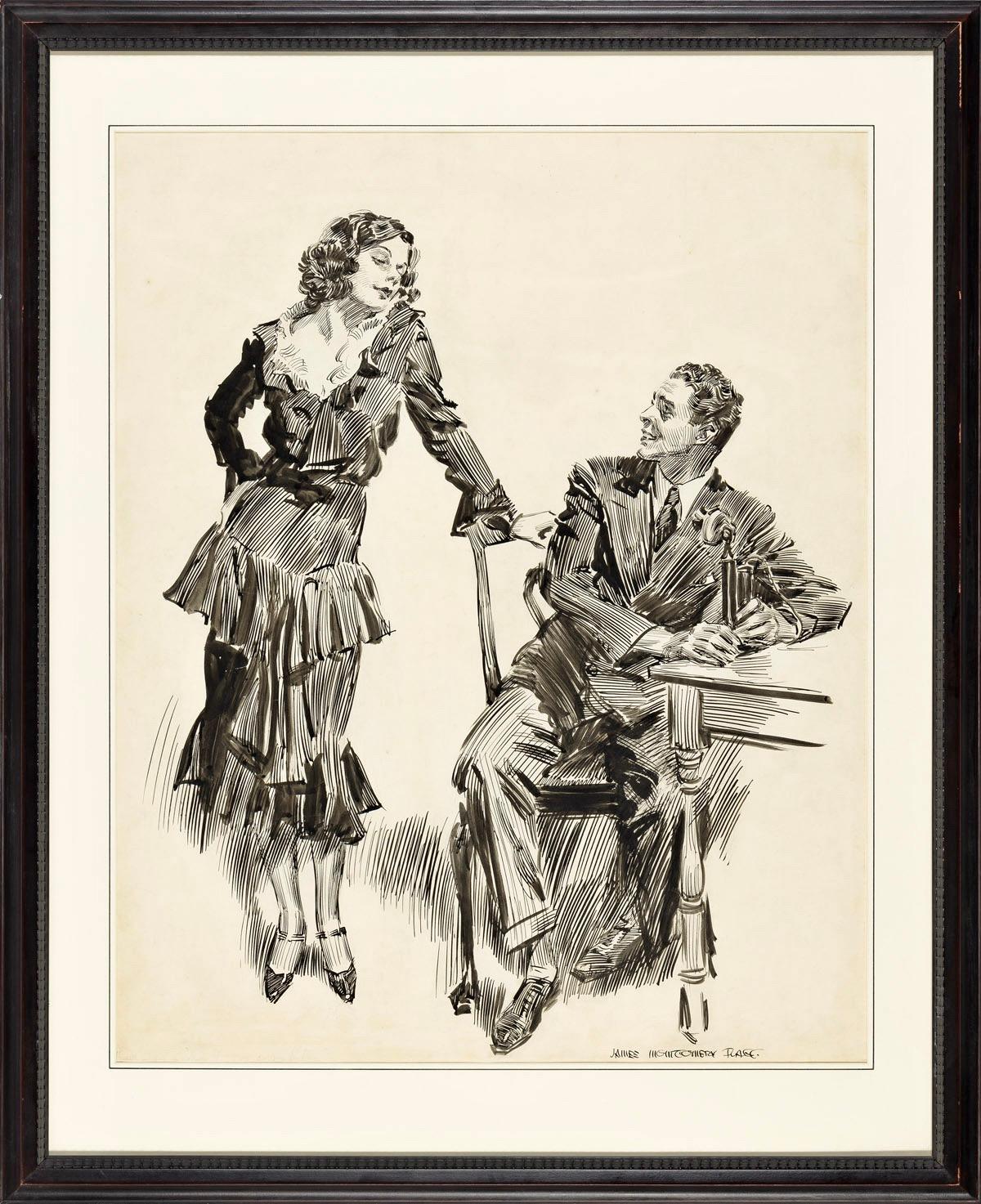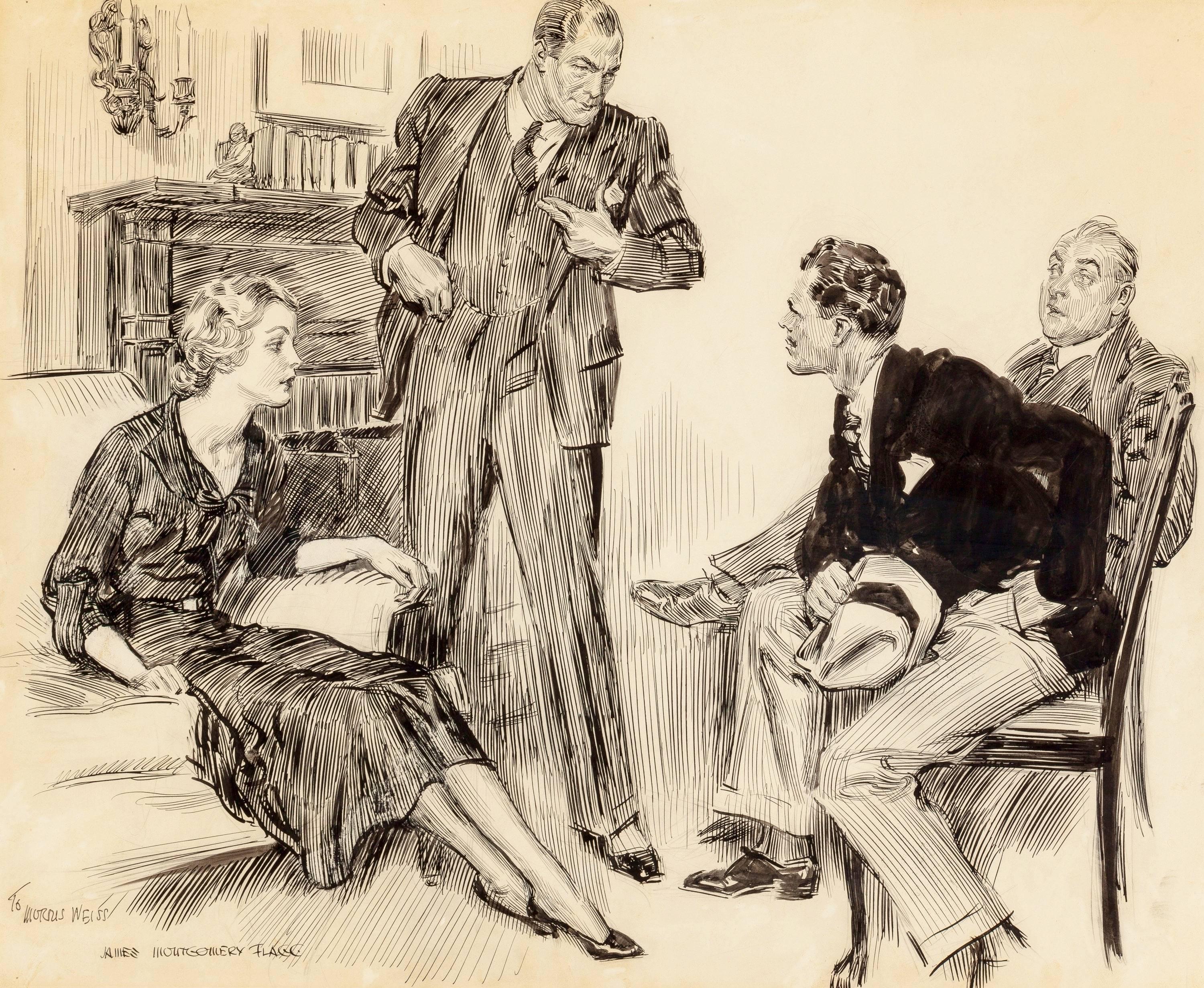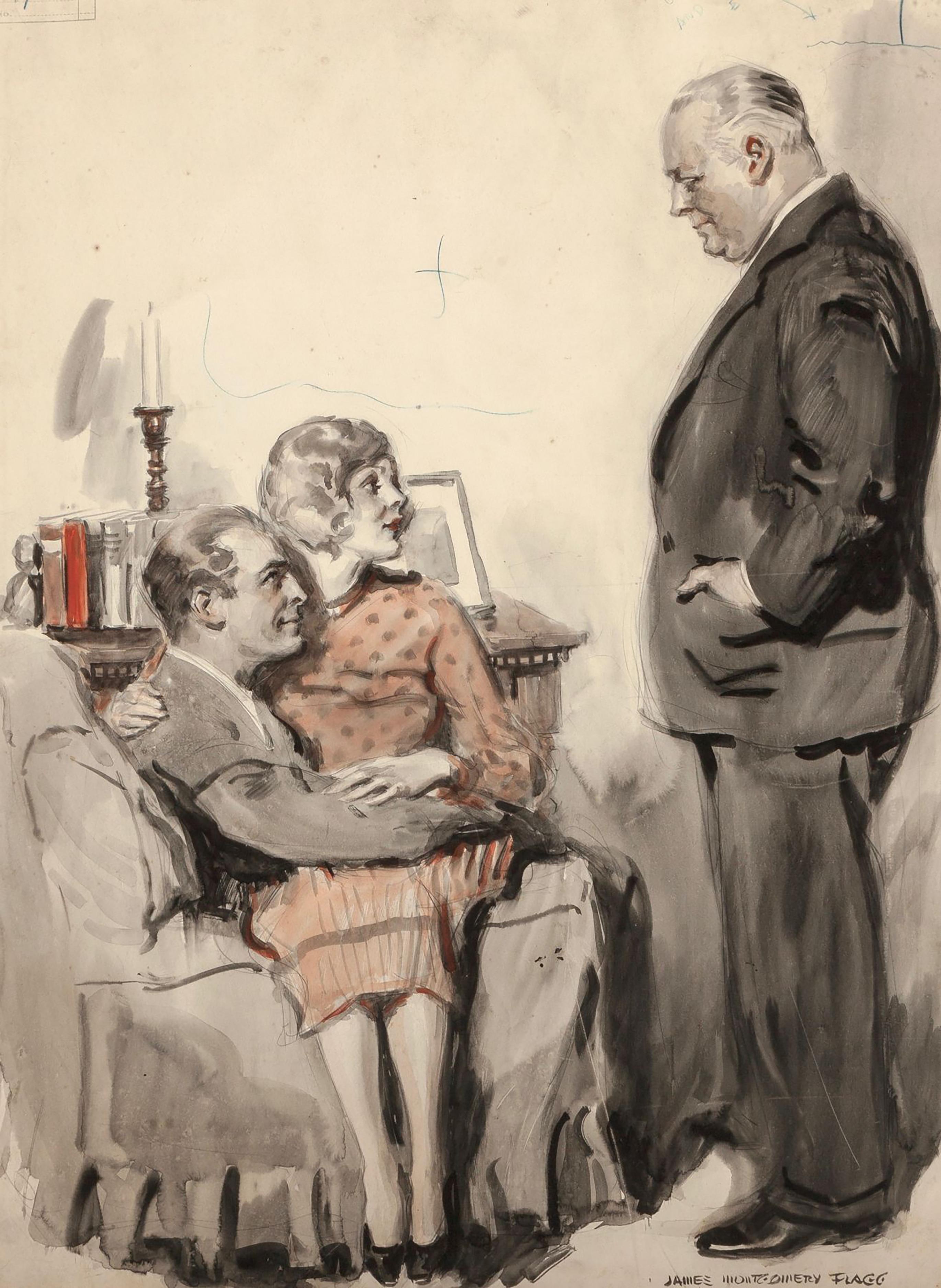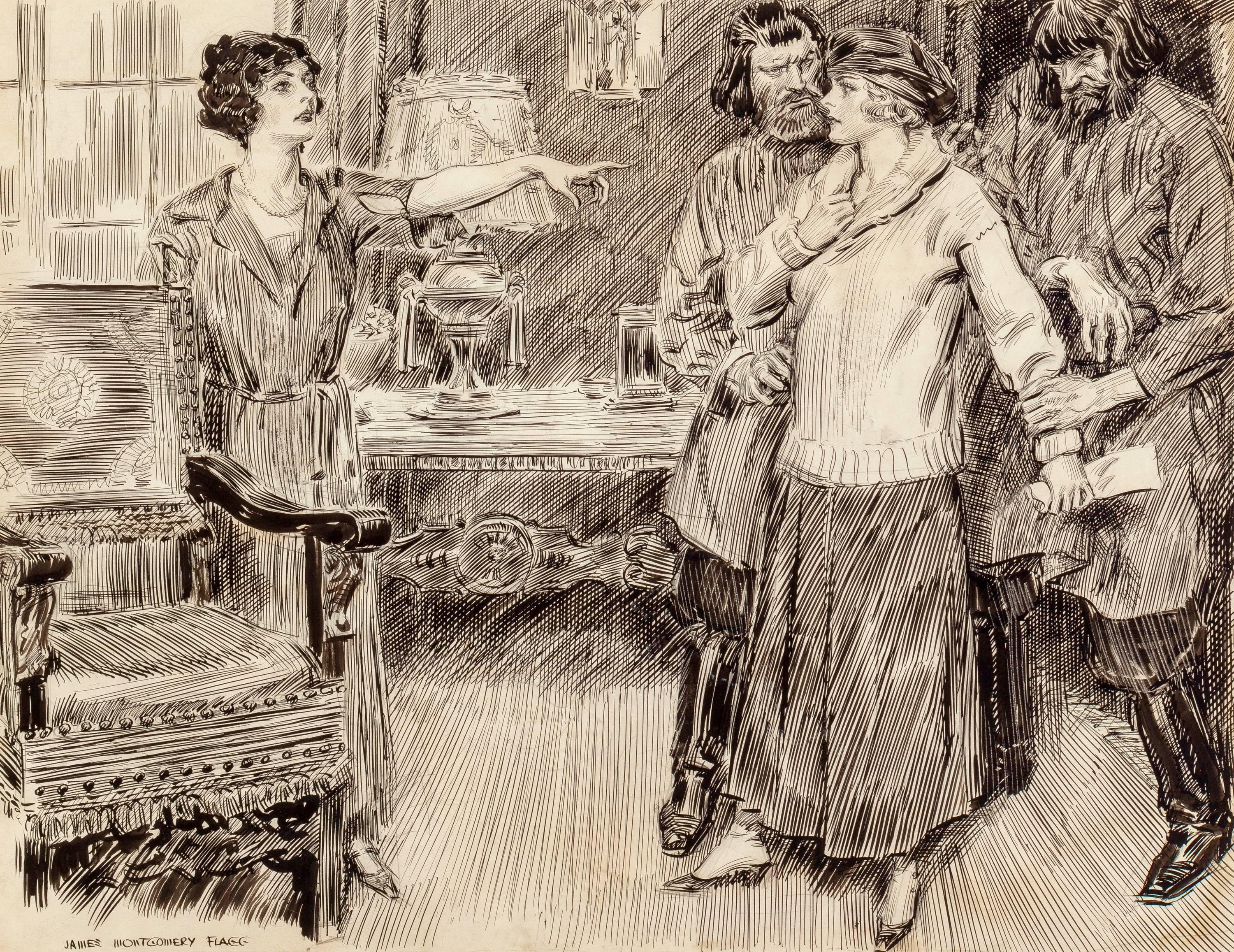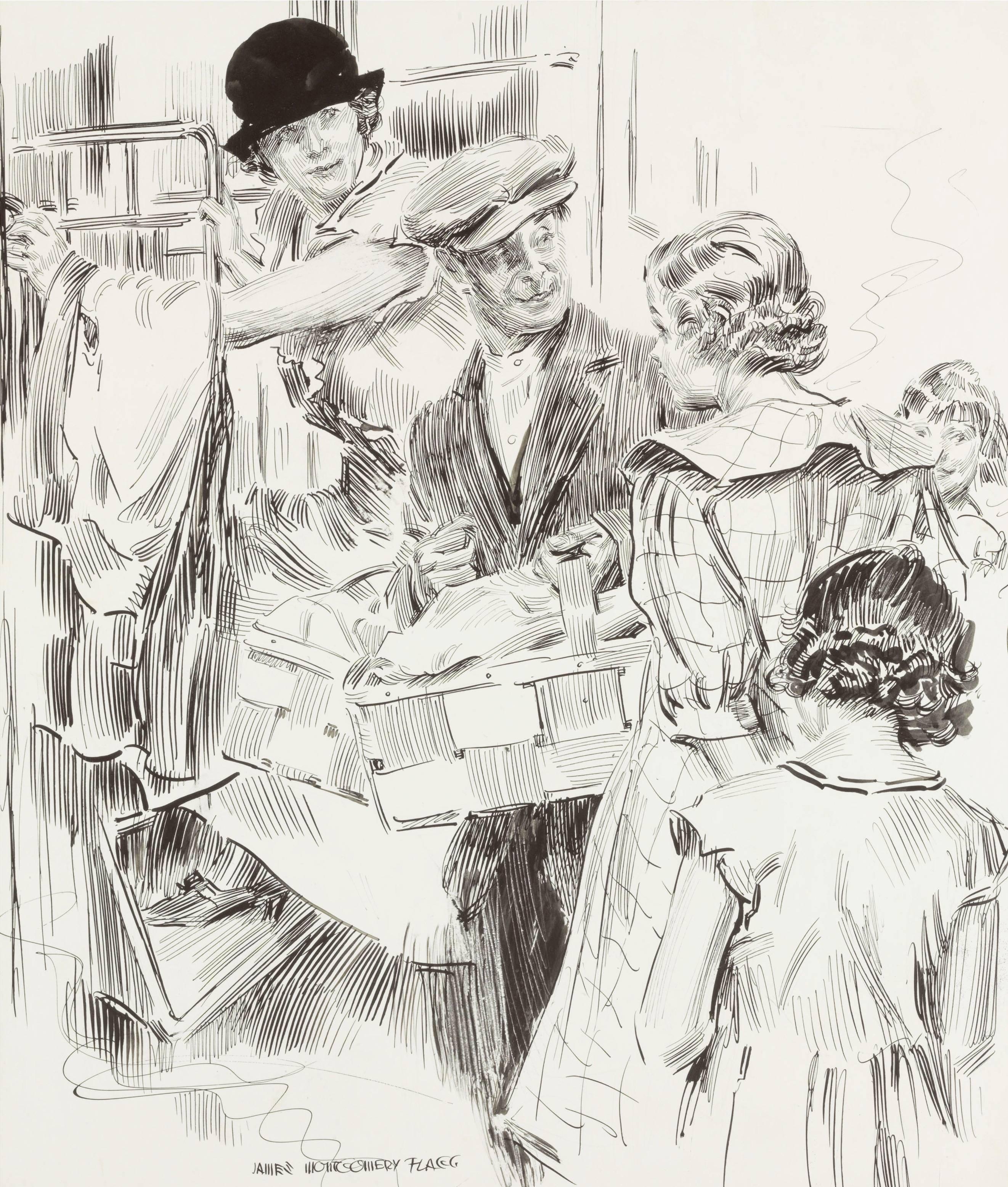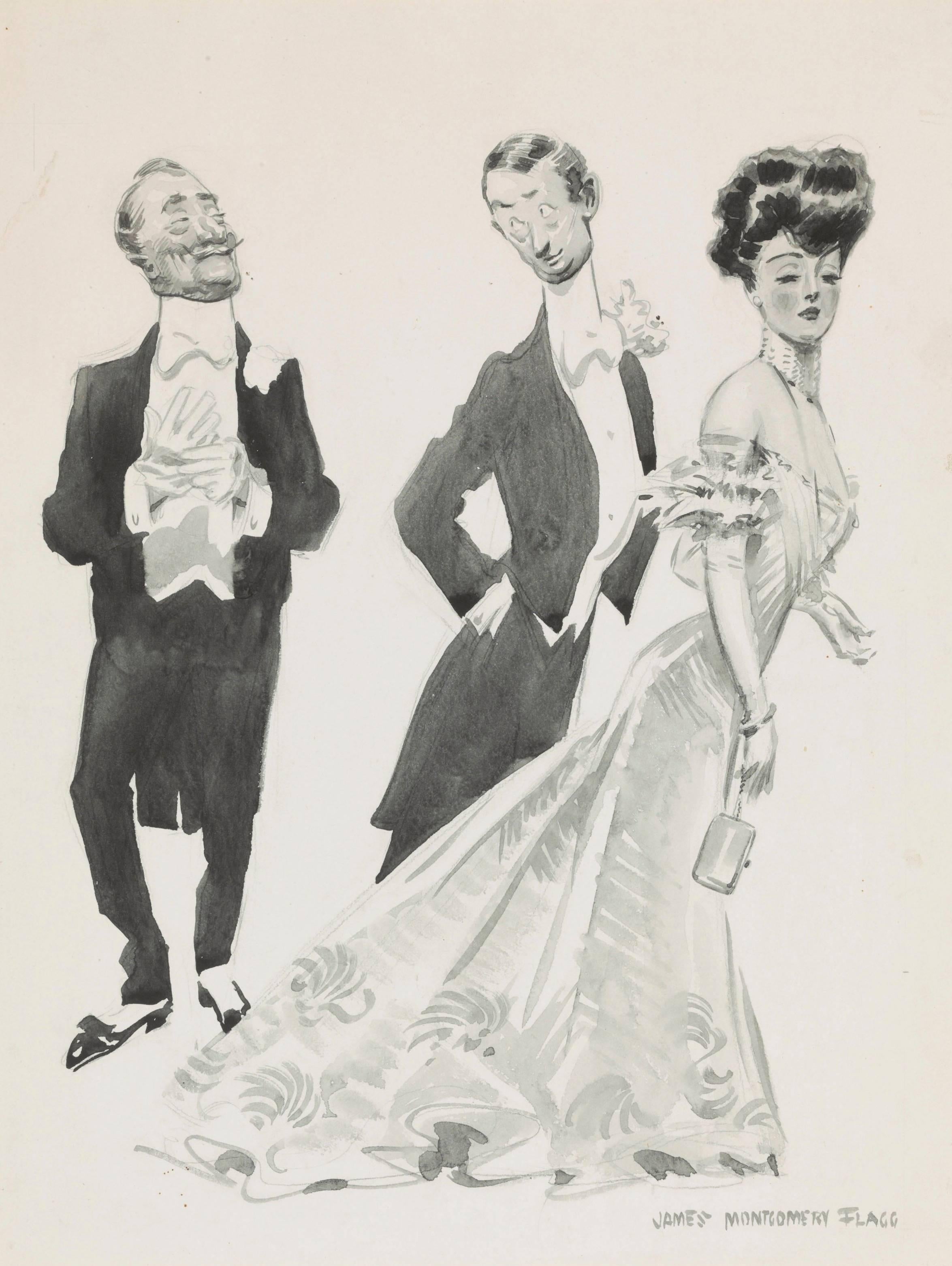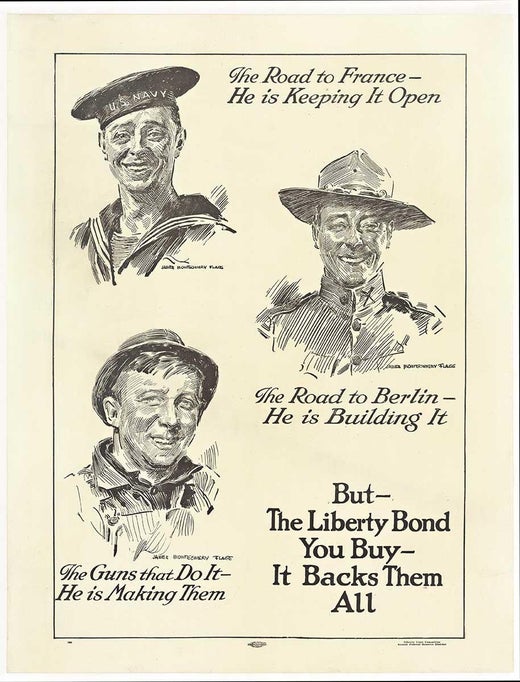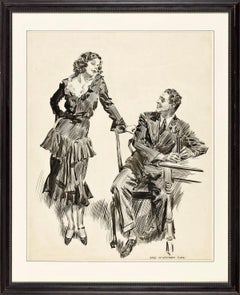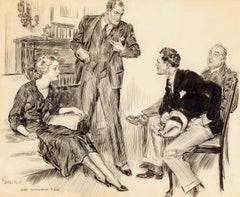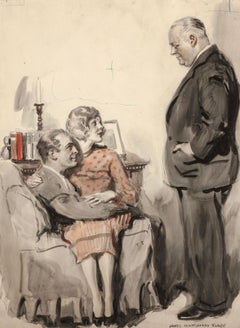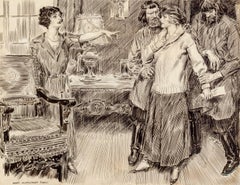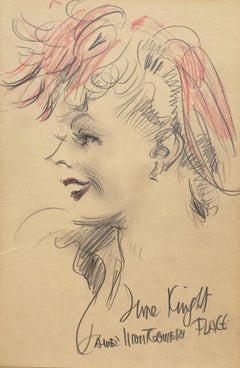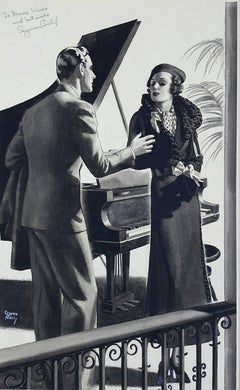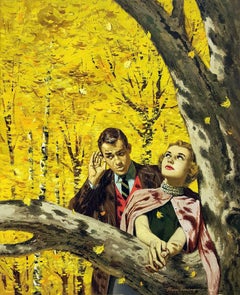Items Similar to “She struggled until she heard him telling her to be quiet.”
Want more images or videos?
Request additional images or videos from the seller
1 of 8
James Montgomery Flagg“She struggled until she heard him telling her to be quiet.”1933
1933
$4,500
£3,396.03
€3,887.94
CA$6,346.49
A$6,967.66
CHF 3,635.04
MX$84,318.35
NOK 45,559.60
SEK 42,929.12
DKK 29,022.41
About the Item
Story illustration for “Tin Crown” by Rex Beach for Cosmopolitan, published February 1933, page 61.
Battling writer's block, songwriter Bertram Berry relies on the hidden talents of Rosa Turini, a shy but gifted composer. Joe Dugan, Berry's astute publisher, recognizes Rosa as the true creative genius behind Berry's recent hits. Berry marries Rosa, primarily to have access to a steady stream of music to plagiarize, then quickly begins an affair with the wealthy Isabel Clark, seeking a divorce from Rosa.
In a pivotal scene, vividly illustrated by James Montgomery Flagg, a heartbroken Rosa calls Joe, hinting at her willingness to concede to a divorce. Joe picks her up to talk, but their drive is interrupted by a staged "stick-up." Two men emerge from a nearby car, ordering them to put up their hands. Rosa screams as one man forces her out of the car and demands she remove her dress, despite Joe's furious protests. Joe quickly realizes it's a setup: "It's a frame-up! Cameraman and everything!" A third man, unmasked, sets up a camera, confirming Berry's elaborate scheme to create a compromising photograph of a half-clad Rosa and Joe. This would force a divorce, ostensibly saving Berry from alimony payments while ruining Rosa's reputation. After the blinding flash of the camera, the assailants flee, leaving a shaken and confused Rosa and an enraged Joe.
The scheme fails to achieve Berry's desired outcome. His divorce is announced, followed swiftly by his marriage to Isabel Clark. However, Isabel soon discovers Berry's financial troubles and his inability to compose, leading to her quick disillusionment and eventual divorce from him. Meanwhile, Joe Dugan offers Rosa a job as a composer at Mink and Dugan, pushing her to overcome her insecurity and embrace her talent. The story concludes with Berry, now broke and creatively dry, seeing Rosa's new hit song, realizing her success while he faces ruin.
Medium: Watercolor and Pencil on Board
Signature: Signed Lower Left
- Creator:James Montgomery Flagg (1877 - 1960, American)
- Creation Year:1933
- Dimensions:Height: 19 in (48.26 cm)Width: 23 in (58.42 cm)
- Medium:
- Movement & Style:
- Period:
- Condition:
- Gallery Location:Fort Washington, PA
- Reference Number:Seller: 21431stDibs: LU38431158413
James Montgomery Flagg
James Montgomery Flagg was a prodigious illustrator, working as a contributing artist to Life magazine at the surprisingly young age of 14. Flagg was born on June 18, 1877, in the Village of Pelham. He is most famous for creating the first image of the fictional Uncle Sam. His ‘I Want You’ lithographed image of Uncle Sam was published in 1917, during the First World War. It is storied that Flagg used his own image as the model for Uncle Sam, imagining himself as a much older man and with facial hair. Flagg died on May 27, 1960, in New York.
About the Seller
5.0
Recognized Seller
These prestigious sellers are industry leaders and represent the highest echelon for item quality and design.
Platinum Seller
Premium sellers with a 4.7+ rating and 24-hour response times
Established in 1995
1stDibs seller since 2016
136 sales on 1stDibs
Typical response time: 1 hour
- ShippingRetrieving quote...Shipping from: Fort Washington, PA
- Return Policy
Authenticity Guarantee
In the unlikely event there’s an issue with an item’s authenticity, contact us within 1 year for a full refund. DetailsMoney-Back Guarantee
If your item is not as described, is damaged in transit, or does not arrive, contact us within 7 days for a full refund. Details24-Hour Cancellation
You have a 24-hour grace period in which to reconsider your purchase, with no questions asked.Vetted Professional Sellers
Our world-class sellers must adhere to strict standards for service and quality, maintaining the integrity of our listings.Price-Match Guarantee
If you find that a seller listed the same item for a lower price elsewhere, we’ll match it.Trusted Global Delivery
Our best-in-class carrier network provides specialized shipping options worldwide, including custom delivery.More From This Seller
View All"A Six-Letter Word Meaning Trouble" Story Illustration, Good Housekeeping
By James Montgomery Flagg
Located in Fort Washington, PA
Signed "James Montgomery Flagg" Lower Right by Artist
"'I've found a woman to sew on buttons,' he said politely. 'Have I?' he inquired of Nancy. 'Big Boy, you have.'" Illustration ...
Category
1930s Mixed Media
Materials
Ink
The Discussion
By James Montgomery Flagg
Located in Fort Washington, PA
Medium: Ink on Board
Signature: Signed and Inscribed Lower Left
James Montgomery Flagg lived with gusto. He epitomized the public concept of the handsome, bohemian artist, surro...
Category
20th Century Other Art Style Paintings
Materials
Board, Ink
As Easy as Kiss Me Hand
By James Montgomery Flagg
Located in Fort Washington, PA
Signed Lower Right
Category
20th Century Figurative Drawings and Watercolors
Materials
Paper, Watercolor
The Big Accusation
By James Montgomery Flagg
Located in Fort Washington, PA
Medium: Pen and Ink on Paper
Signature: Signed Lower Left
James Montgomery Flagg lived with gusto. He epitomized the public concept of the handsome, bohemian artist, surrounded ...
Category
20th Century Other Art Style Paintings
Materials
Ink, Paper, Pen
Setting Off
By James Montgomery Flagg
Located in Fort Washington, PA
Medium: Ink on Paperboard
Dimensions: 24.50" x 21.00"
Signature: Signed 'James Montgomery Flagg' Lower Left
Category
20th Century Figurative Drawings and Watercolors
Materials
Paper, Ink, Board
“Slumming Among the Four Hundred, ” Post Illustration
By James Montgomery Flagg
Located in Fort Washington, PA
Original illustration for the article “Slumming Among the Four Hundred” by Alfred Henry Lewis, for The Saturday Evening Post, published November 2, 1907.
The article offers a satiri...
Category
20th Century Romantic Paintings
Materials
Ink, Board, Paper, Pencil
You May Also Like
Actress June Knight
By James Montgomery Flagg
Located in Miami, FL
Celebrity portrait sketch of
actress June Knight but James Montgomery Flagg on card stock in two colors.
Signed and inscribed lower right. The work is unframed.
There
is a slight cr...
Category
1930s Academic Portrait Drawings and Watercolors
Materials
Crayon, Pencil
Art Deco Coulple Magazine Story Illustration, RedBook The Saturday Evening Post
By Seymour Alling Ball
Located in Miami, FL
Signed lower left: Seymour Ball Inscribed upper left: To Morris E Weiss with best wishes Seymour Ball" Matted not framed
Category
1930s Art Deco Figurative Drawings and Watercolors
Materials
India Ink, Watercolor, Illustration Board
Love Story, Illustration for the Saturday Evening Post
By Bruce Bomberger
Located in Miami, FL
An illustrator for Time, Life, Look, True, True West, Saturday Evening Post, Good Housekeeping, Readers Digest, and others, he also painted for adverti...
Category
1950s American Realist Figurative Paintings
Materials
Gouache
Love Story, Illustration for the Saturday Evening Post
By Bruce Bomberger
Located in Miami, FL
An illustrator for Time, Life, Look, True, True West, Saturday Evening Post, Good Housekeeping, Readers Digest, and others, he also painted for adverti...
Category
1950s American Realist Figurative Paintings
Materials
Gouache
Film Noir. Pulp Mystery That police officer knows you. Saturday Evening Post
By Paul Rabut
Located in Miami, FL
Film noir crime drama painted in a single frame. In narrative art, telling a story in a single image is harder than doing it in episodes. "'That police officer...
Category
1950s American Realist Figurative Paintings
Materials
Mixed Media
All She Wanted Was To Be Someone's Most Precious Person
By The Connor Brothers
Located in Miami, FL
TECHNICAL INFORMATION:
The Connor Brothers
All She Wanted Was To Be Someone's Most Precious Person
2017
Pigment print with silkscreen
47 1/4 x 29 1/2 ...
Category
21st Century and Contemporary Contemporary Figurative Prints
Materials
Archival Pigment, Screen
More Ways To Browse
Watercolors Faces
Writers Block
Art Brown Drawings
Drawings Vintage Frame
Black And White Painting Drawing
Contemporary Ink Drawings And Watercolors
Figure Drawings
Framed Watercolor Landscape
American Watercolours
Vintage Pastel Art
19th Century Watercolour
Watercolor Paintings Of A Flower
Nude Watercolour Paintings
French Watercolour Painting
White Watercolor Painting
Watercolor Still Life
Watercolour Paintings France
British Watercolour
